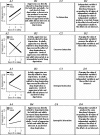Equivalence class formation: a method for teaching statistical interactions
- PMID: 20190920
- PMCID: PMC2741420
- DOI: 10.1901/jaba.2009.42-575
Equivalence class formation: a method for teaching statistical interactions
Abstract
Many students struggle with statistical concepts such as interaction. In an experimental group, participants took a paper-and-pencil test and then were given training to establish equivalent classes containing four different statistical interactions. All participants formed the equivalence classes and showed maintenance when probes contained novel negative exemplars. Thereafter, participants took a second paper-and-pencil test. Participants in the control group received two versions of the paper-and-pencil test without equivalence-based instruction. All participants in the experimental group showed increased paper-and-pencil test scores after forming the interaction-indicative equivalence classes. Class-indicative responding also generalized to novel exemplars and the novel question format used in the paper-and-pencil test. Test scores did not change with repetition for control group participants. Implications for behavioral diagnostics and teaching technology are discussed.
Keywords: college students; computer-based training; equivalence classes; generalization to novel exemplars.
Figures





Similar articles
-
Equivalence class formation in a trace stimulus pairing two-response format: effects of response labels and prior programmed transitivity induction.J Exp Anal Behav. 2009 Jul;92(1):57-84. doi: 10.1901/jeab.2009.92-57. J Exp Anal Behav. 2009. PMID: 20119522 Free PMC article.
-
Comparison of a stimulus equivalence protocol and traditional lecture for teaching single-subject designs.J Appl Behav Anal. 2011 Winter;44(4):819-33. doi: 10.1901/jaba.2011.44-819. J Appl Behav Anal. 2011. PMID: 22219532 Free PMC article.
-
Nodal structure and stimulus relatedness in equivalence classes: post-class formation preference tests.J Exp Anal Behav. 2011 May;95(3):343-68. doi: 10.1901/jeab.2011.95-343. J Exp Anal Behav. 2011. PMID: 21547071 Free PMC article.
-
Nodal structure and the partitioning of equivalence classes.J Exp Anal Behav. 2008 May;89(3):359-81. doi: 10.1901/jeab.2008-89-359. J Exp Anal Behav. 2008. PMID: 18540220 Free PMC article.
-
Teaching statistical variability with equivalence-based instruction.J Appl Behav Anal. 2015 Dec;48(4):883-94. doi: 10.1002/jaba.249. Epub 2015 Sep 22. J Appl Behav Anal. 2015. PMID: 26391521
Cited by
-
An Evaluation of Two Stimulus Equivalence Training Sequences on the Emergence of Novel Intraverbals.Anal Verbal Behav. 2016 Nov 8;32(2):171-193. doi: 10.1007/s40616-016-0072-4. eCollection 2016 Oct. Anal Verbal Behav. 2016. PMID: 30800624 Free PMC article.
-
Sidman Goes to College: A Meta-Analysis of Equivalence-Based Instruction in Higher Education.Perspect Behav Sci. 2018 Apr 26;41(1):95-119. doi: 10.1007/s40614-018-0150-0. eCollection 2018 Jun. Perspect Behav Sci. 2018. PMID: 31976392 Free PMC article.
-
An evaluation of the stimulus equivalence paradigm to teach single-subject design to distance education students via Blackboard.J Appl Behav Anal. 2012 Summer;45(2):329-44. doi: 10.1901/jaba.2012.45-329. J Appl Behav Anal. 2012. PMID: 22844140 Free PMC article.
-
Toward a technology of derived stimulus relations: an analysis of articles published in the journal of applied behavior analysis, 1992-2009.J Appl Behav Anal. 2011 Spring;44(1):109-19. doi: 10.1901/jaba.2011.44-109. J Appl Behav Anal. 2011. PMID: 21541138 Free PMC article. Review.
-
Using Stimulus-Equivalence Technology to Teach Skills About Nutritional Content.Perspect Behav Sci. 2020 Apr 21;43(3):469-485. doi: 10.1007/s40614-020-00250-2. eCollection 2020 Sep. Perspect Behav Sci. 2020. PMID: 33024929 Free PMC article.
References
-
- Adams B.J, Fields L, Verhave T. Formation of generalized equivalence classes. The Psychological Record. 1993;43:553–566.
-
- Arntzen E, Holth P. Probability of stimulus equivalence as a function of training design. The Psychological Record. 1997;47:309–320.
-
- Belanich J, Fields L. Generalized equivalence classes as response transfer networks. The Psychological Record. 2003;53:373–414.
-
- Bradstreet T.E. Teaching introductory statistics courses so that nonstatisticians experience statistical reasoning. The American Statistician. 1996;50:69–78.
-
- Branch M. Stimulus generalization, stimulus equivalence, and response hierarchies. In: Hayes S.C, Hayes L.J, Sato M, Ono K, editors. Behavior analysis of language and cognition. Reno, NV: Context Press; 1994. pp. 51–70. In.
MeSH terms
LinkOut - more resources
Full Text Sources

